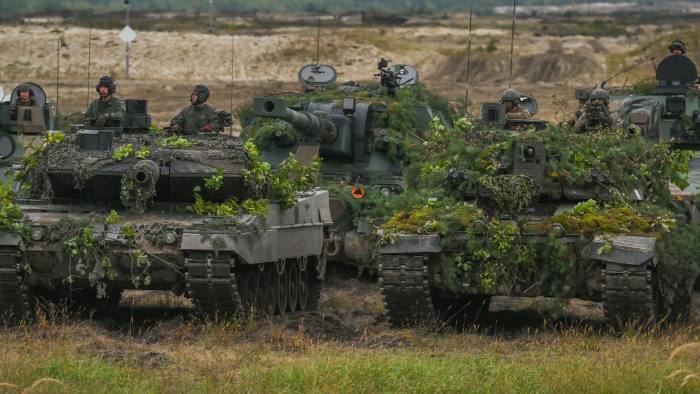Will Leopard 2 tanks actually boost Ukraine's battlefield chances?
Success or failure will depend on extensive training and a plentiful flow of western arms and ammunition
 Commentators have overestimated the impact of individual pieces of military equipment, such as Leopard 2 tanks, on the course of the war © Artur Widak/NurPhoto/Getty Images
Commentators have overestimated the impact of individual pieces of military equipment, such as Leopard 2 tanks, on the course of the war © Artur Widak/NurPhoto/Getty Images
Receive free War in Ukraine updates
We’ll send you a myFT Daily Digest email rounding up the latest War in Ukraine news every morning.
The writer is a senior research fellow at the International Institute for Strategic Studies
In the high-stakes diplomatic furore around the delivery of Leopard 2 main battle tanks to Ukraine, an essential part of the debate has been lost. This missing piece is the military reality — in particular what impact these contested vehicles will have on the battlefield.
Chancellor Olaf Scholz has held back, until this week, in allowing other countries to send the tanks to Ukraine or deploying Germany’s own Leopard 2s. The chancellor’s fear of escalation made little sense given the delivery of weapons systems with greater firepower. Some German policymakers urging bolder action declared Leopard 2s to be the key to Kyiv’s victory.
But both Scholz and these commentators have overestimated the impact of individual pieces of equipment on the course of the war. Military power is not about a single platform — it relies on force structure, doctrine, logistics and supply, and intangible factors such as morale, training and leadership. This cumulative whole is hard to measure.
In the case of the Leopard 2, battlefield effectiveness will largely depend on Ukraine’s ability to conduct what is known as combined arms operations, comparable to a deadly game of rock, paper, scissors, in which the strengths of one platform or weapon systems supplements the strengths and weaknesses of another. Leopard 2s would ideally be deployed alongside armoured infantry fighting vehicles, self-propelled artillery, air defence systems, and electronic warfare. This can only be accomplished through extensive training, changes in doctrine, and the continuous flow of western arms and ammunition.
The US is leading the way in this type of combined arms training at a facility in Germany, where Ukrainian units are taught how to better co-ordinate company and battalion-sized formations in battle. But Washington’s promise to supply M1 Abrams tanks will add extra complexities to Kyiv’s operations, given these have differing abilities and logistical requirements to the Leopard 2s. Modern combined arms operations have their origins in the later years of the first world war, when imperial Germany devised new tactics to overcome the artillery-dominated Western Front. Ukraine’s allies are now hoping these tactics will help Kyiv prevail in the grinding attritional fight against Russia.
Ukraine currently employs its fleet of Soviet-era main battle tanks in indirect fire support missions rather than tank-on-tank warfare. To take full advantage of the Leopard 2 (which has superior armour and a more accurate cannon than Russian tanks), Kyiv would have to evolve a new strategy for offensive operations. The strength of these tanks lies in sheer numbers: Ukraine must be able to operate and sustain at least one armoured brigade consisting of up to 100 Leopard 2s to have a significant impact on the conflict. This will be extremely challenging, but not impossible.
Notably, military power is always relative. To quote the former US defence secretary James Mattis, “the enemy gets a vote”. Therefore Russia’s reaction to the Leopard 2 will partially determine its impact. Even were Ukraine to succeed in fielding an entire armoured brigade or more, Moscow’s forces are likely to adapt, eventually diminishing its power.
This is not to say Germany has been right to deliberate over the delivery of Leopard 2s. In fact, Berlin’s indecision has already cost it valuable political capital in eastern Europe and across the Atlantic, despite it being one of Kyiv’s largest suppliers of military aid.
This is far from being the last major arms package that Ukraine will need from the west. Manned fighter aircraft could well be the next item on Kyiv’s shopping list. The Germans need a more nuanced understanding of military power so they can act rather than react to the shifting fortunes of war. Above all, Berlin needs to learn that military power, if applied realistically and for the right cause, can be a force of good in the world — not just something to fear.

















































![SILVERBACK SERVER VS ORANGUTAN OOGA BOOGA 🍔🥊 [I GUESS HE COULDN'T HAVE IT HIS WAY]](https://bfn.today/@btc/live/cover_images/d576WL2AwSIp/yq6FOFGqx815_640x360.jpg.webp)








